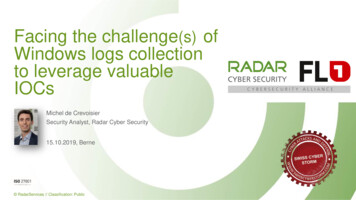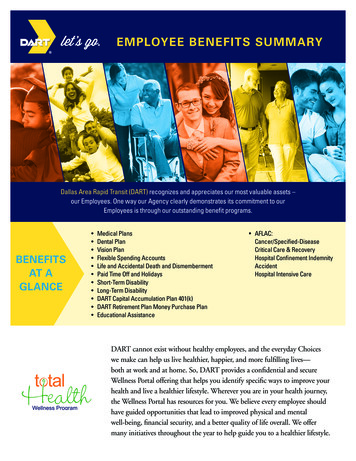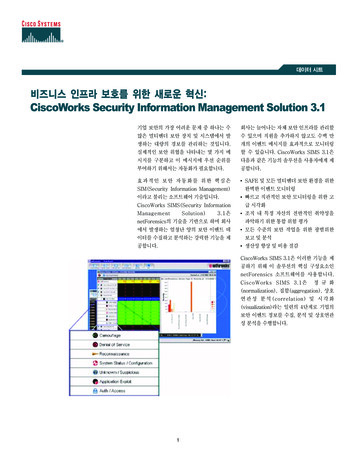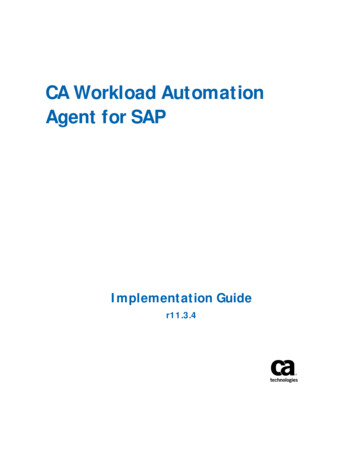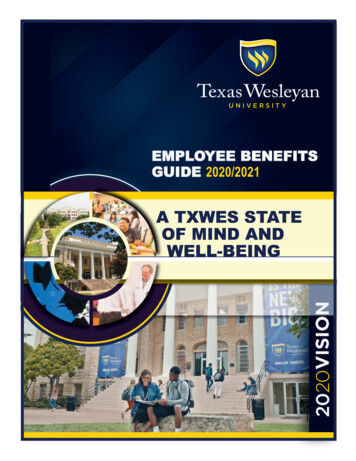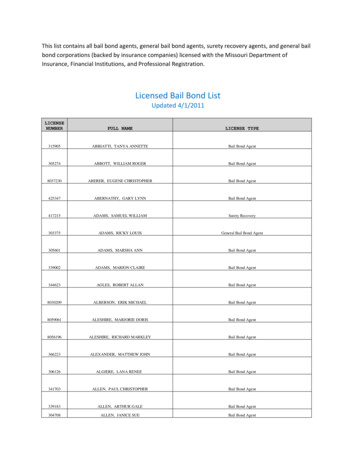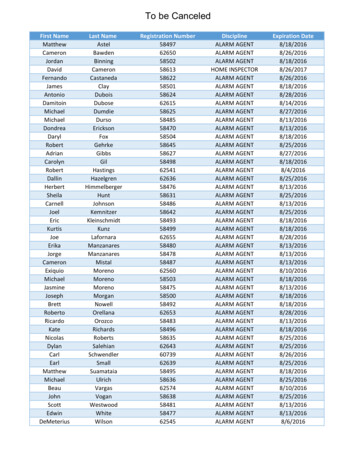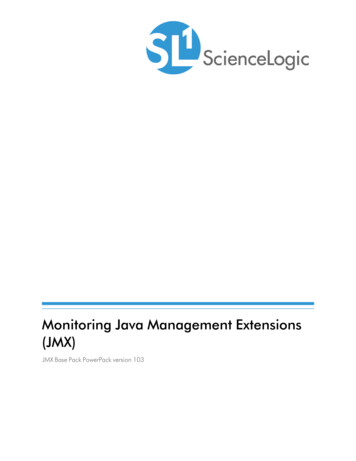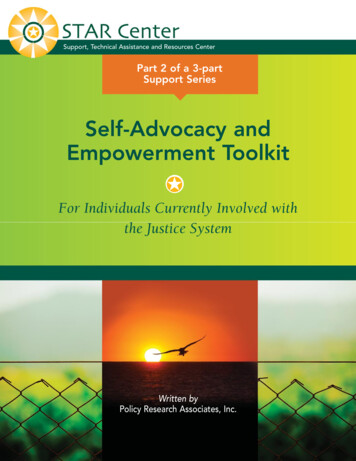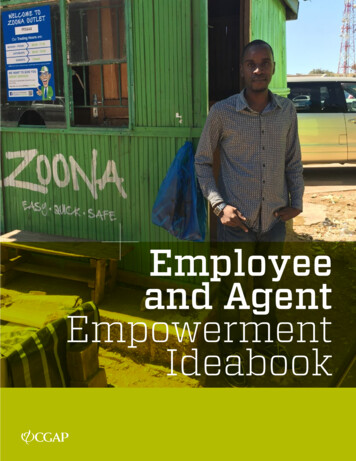
Transcription
Employeeand AgentEmpowermentIdeabook
customersguide.cgap.org/resourcesCGAP Employee and AgentEmpowerment IdeabookCGAP Customer-Centric GuideThis Ideabook expands on cases in thetools and direction for financial service providersaccompanying CGAP Employee and Agenton the journey toward customer centricity. ThisEmpowerment Toolkit, highlighting the resourcesdigital collection of toolkits, case studies, andeach organization leveraged and strengthenedexperiments teaches providers exactly how to deliverto achieve its customer-centric goals. Theproducts and services designed specifically forIdeabook’s 23 Tips Templates are practicallow-income customers. Providers will also discovertools and exercises that provide ideas on how tohow to transform business challenges into strongget closer to your employees and agents – andopportunities to engage and retain customers – nowmake customer experience a core competencyand in the future.within your organization.2 cgap.orgThe CGAP Customer-Centric Guide offers hands-on
EMPLOYEE AND AGENTEMPOWERMENT IDEABOOKTable ofContentsIntroduction. 6Overview of Case Studies. 7AMK, Cambodia.9BTPN, Indonesia. 17Equity Bank, Kenya.25FINCA Impact Finance, Global. 30JUMO, Sub-Saharan Africa.38Pioneer Microinsurance, the Philippines. 46Quicken Loans, USA.54Zoona, Zambia.59Tips Templates (T Ts). 67T T 1: Individual Empowerment Diagnostic. 68Template for Individual Empowerment Diagnostic for Managers.70Template for Individual Empowerment Diagnostic for Employees and Agents .73T T 2: Employee or Agent Persona Profile. 76Tips Templates in Practice: Persona for BTPN Agent. 77Template for Persona Profile.78T T 3: Employee and Agent Surveys. 80Tips Templates in Practice: Pioneer Microinsurance Employee Satisfaction Survey.82Employee and Agent Empowerment Ideabook 3
Table of Contents (continued)T T 4: Performance Metrics.83Tips Templates in Practice: Pioneer Microinsurance Balanced Scorecard.85T T 5: Journey Mapping Tool for Agents and Customer-Facing Staff.87Template for Employee or Agent Journey Mapping.89T T 6: Agent Performance/Float Tracker. 90Template: Agent Performance/Float Tracker (Excel file). 90T T 7: H.E.A.T.: Customer De-escalation Tool.91Tips Templates in Practice: Angry Customer Scenarios. 93T T 8: Managing Your Mood.95Tips Templates in Practice: Moody Manager Scenario.97T T 9: Empathy Story Mapping. 98Empathy Story Map Template. 99Tips Templates in Practice: Example from Pioneer Microinsurance Staff.100T T 10: Clarity Around Roles. 101Tips Templates in Practice: Clarity Around Roles at OK Bank, Philippines. 102T T 11: Know Your (Internal) Customer.103Who Are Your Customers Template. 104T T 12: 360-Degree Feedback.105T T 13: Sharing Feedback and Development Dialogues.107Three Tips to Be More Effective in Sharing Feedback. 108T T 14: Co-Creating Performance Goals.111Tips Templates in Practice: Sample Scorecard for Pioneer Microinsurance.113Sample Scorecards for Individuals.114T T 15: Vision of Perfect. 115Template for a Vision of Perfect Statement.1164 cgap.org
EMPLOYEE AND AGENTEMPOWERMENT IDEABOOKTable of Contents (continued)T T 16: Service Level Agreements.120Tips Templates in Practice: Pioneer Microinsurance, Philippines.122T T 17: Usability Testing.124Tips Templates in Practice: Artoo Usability Testing. 126T T 18: Aligning Rewards to Customer-Centric Strategy.128Tips Templates in Practice: Example of Rewards Payout Depending on Performance.131T T 19: Non-Monetary Rewards. 132T T 20: Process Map.134Tips Templates in Practice: Sample Process Maps.135T T 21: Agent Selection Tool.136Tips Templates in Practice: Agent Selection at Letshego Financial Services, Mozambique . 140T T 22: Agent Pitch. 141Tips Templates in Practice: Agent Selection at Letshego Financial Services, Mozambique. 143Sample Agent Pitch. 144T T 23: Agent Business Case Calculator.145Tips Templates in Practice: AMK, Cambodia. 148Employee and Agent Empowerment Ideabook 5
IntroductionThis Employee and Agent Empowerment Ideabook contains a series of eight case studies and 23 detailedTips Templates (T Ts). The case studies expand on cases presented in the accompanying Employee andAgent Empowerment Toolkit.1 They highlight which of the nine resources (see table below) were leveraged andstrengthened, and what results each organization achieved thanks to those efforts. The T Ts show, step by step,how to implement employee and agent empowerment initiatives to further your customer-centric goals.Resource TypeDescription1. SkillsWhat people need to be able to do to deliver valuable customer experience2. Values and AttitudesBeliefs, priorities, and other psychological assets that can help or hindercustomer experience delivery3. Information andKnowledgeWhat people need to know to be able to commit to customer experience,deliver it, and recognize whether they’re delivering it4. Dialogue and SupportInteractions with others that facilitate improvement in customer experience delivery5. Control and InfluenceOpportunities to take decisions, act, or influence others in pursuit ofcustomer experience6. Tools andInfrastructureThings that people can use to make their delivery of customer experience easieror more effective7. Rewards and Penalties“Carrots and sticks” that can guide and motivate customer experience delivery8. Time and EnergyThe bandwidth available for doing more to deliver customer experiencethan people do today9. MoneyFinancial resources that can be used to deliver customer experience1. -Toolkit.pdf6 cgap.org
EMPLOYEE AND AGENTEMPOWERMENT IDEABOOKOverview of Case TIATIVESRESULTSLow levels of agenttransactions, profitability,and retentionNew channels of dialogueand support, moreactionable information,additional partnerships forincome generation, revisedincentive modelAgent transactions nowrepresent 62 percent ofoverall transaction volume,agent attrition has fallen to3 percentLow agent and customeractivity ratesAgent empowermentplatform (AEP) thatuses gamification toimprove agents’ productknowledge and motivatebetter performancePlatform launched in February2018; success to be measuredby growth in active customersand number of transactionsprocessedExpanding and integratingagent banking into existingbusiness operationsRealigned incentives,training, tools andinfrastructure for agents,growth trajectorySixfold growth in agencytransactions from 2012 (morethan 62 percent of total retailtransactions as of 2017)Instilling customercentricity and empathy inpeopleSharing information, providingtraining and learning support,adjusting talent managementprocessesHigher “Pulse Check” resultsfrom subsidiaries across allfive measurement categoriesEmployee and Agent Empowerment Ideabook 7
ORGANIZATION8 ULTSEmbedding customercentricity in a rapidlyscaling and increasinglydistributed businessCustomer operatingprinciples, EPS dashboard,channels for regularlycontributing to and seeingthe impact of customerfocused initiativesIncreased investment incustomer intelligence projectsand staff, faster responseto changes in customerexperience, EPS score addedto company scorecard – linkingaccountability and rewardsSystematizing customercentricity in an expandingorganizationCo-creation of customercentric qualities, onboardingprogram, Defenders ofCustomer CentricityChallenge, segment-basedengagement plansConsistency in communicationaround customer centricity,customer satisfaction up from78.8 percent to 83.8 percentTreating employees in away that models how theyshould treat customersClarifying, promoting, andsupporting a set of corevalues; institutionalizingfeedback loopsIn 2016, received ninemortgage industry customersatisfaction awards and wasnamed a top-five place towork nationwide by Fortunemagazine for the 13th year ina rowMaintaining a strongagent network in the faceof rapid expansionImproved screening methods,segment- and behaviorfocused engagementstrategies, redesignedagent portalCustomer satisfaction withteller conduct and agentliquidity rose 11 percentagepoints in six months,dominant market positionmaintained
EMPLOYEE AND AGENTEMPOWERMENT IDEABOOKAMK, ULTSLow levels of agent transactions,profitability, and retentionNew channels of dialogueand support, more actionableinformation, additional partnershipsfor income generation, revisedincentive modelAgent transactions now represent 62percent of overall transaction volume, agentattrition has fallen to 3 percentBACKGROUNDAMK2 is one of the leading deposit-taking microfinance institutions in Cambodia, providing services in 98 percentof the country’s communes. It aims to help large numbers of poor people improve their livelihood options throughthe delivery of appropriate and viable financial services. In 2002, AMK was set up as an independent microfinancecompany and since 2010 has offered a range of tailored microfinance services, including credit, insurance, savings,and money transfers. In 2011, AMK launched its agent banking network pilot in three provinces to allow customersto transact conveniently outside the branch network. At the end of 2016, it had agents across all provinces andserved nearly 600,000 customers, predominantly rural women. With its branch and agent network, AMK offersapproximately one contact point for every 850 families in Cambodia.BUSINESS CHALLENGEBetween 2011 and 2016, AMK engaged about 2,300 agents, almost the same amount as its number ofemployees. By the end of that period, it saw high levels of employee retention and satisfaction (89 percent and98 percent, respectively), but low levels of agent transactions and profitability. There was evidence that agentsweren’t keeping up AMK’s brand and image in the same way employees did, and agent attrition was on therise. AMK realized that it had to activate its agent network but had to do so in a way that empowered agents todeliver positive customer experience – not just profitable transactions.2. https://www.amkcambodia.com/index.htmlEmployee and Agent Empowerment Ideabook 9
RESOURCE STRATEGYAMK’s concern for customers has been at the heart of its foundation and evolution. Once agents were identifiedas “internal” customers, AMK was able to leverage its customer-centric leadership and culture to open newchannels of dialogue and support for agents, and to provide them with information, infrastructure, and incentivesthat made it possible for them to earn more and spend less as AMK agents. The more agents understood andbelieved in their ability to contribute to AMK’s mission while benefitting themselves, the more agents becamewilling to collaborate with AMK and to invest time and energy in making that collaboration successful.WHAT ALREADY EXISTEDAND WAS LEVERAGEDWHAT THE EMPOWERMENTINITIATIVE(S) ADDED ORSTRENGTHENEDWHAT CHANGED AS A RESULTEMPOWERMENT INITIATIVE DESIGN AND IMPLEMENTATIONPreparingBetween 2014 and 2016, AMK invested in employee empowerment, enhancing the voice of staff, decentralizingdecision-making, and aligning incentives, among other changes. These initiatives strengthened employeeengagement and demonstrated to AMK that when this group of internal customers is treated well, they aremore willing and able to treat external customers well.AMK’s relationship with agents during this period was quite different. Agents were not subject to the samerigorous selection and training process as employees; they were not part of AMK’s organizational culture orincentive plan; and while they were managed by mobile banking officers (MBOs), accountability was less thanin a staff-manager relationship. AMK realized that if it wanted agents to deliver the same quality of serviceas employees, it needed to treat them more like internal customers, enhance their ability to serve externalcustomers, and give them a more compelling reason to engage with AMK.10 cgap.org
EMPLOYEE AND AGENTEMPOWERMENT IDEABOOKLearningAMK’s leadership was anecdotally aware of some of the underlying reasons for the limited success of its agentchannel. Lack of agent knowledge, inefficient processes, insufficient agent incentives, and limited integrationof agents into the rest of the organization all played a part. What was unclear was the magnitude of eachproblem, which to prioritize, and how to address them.In mid-2016, AMK hired a Cambodian design thinking firm, 17 Triggers, to help map the agent journey andidentify pain points along the way. Agents were clustered by performance levels (based on the number ofmoney transfer transactions and services they were offering) and classified across rural and urban areas,resulting in eight agent segments. Representatives of these segments, as well as the customers they serve, wereinterviewed using a human-centered design approach. One advantage of the clustering was that researcherscould hone in on positive deviants and learn from those success cases in addition to identifying key pain pointsof many other agents.As shown in the image below, the research identified lack of agent motivation as one of the key drivers for lowcustomer traffic. It also found that not all agents had the business skills to attract customers. Agents commonlycomplained about the slow and confusing agent application interface, their lack of familiarity with AMK’s products,poor marketing collateral, and the lack of a support system to make them feel like a part of the AMK family.CreatingOnce agent pain points were identified, the research team ideated solutions and selected three for pilottests, based on their potential to trigger desired agent behavior and improve customer experience. Actualimplementation was shaped by two major challenges: new regulations in March 2017 that imposed an interestrate cap of 18 percent on all loans given by microfinance institutions in Cambodia, and an upgrade to AMK’score banking and switching system. Since then, some projects have been delayed due to AMK’s need toprioritize projects related to operational efficiency and productivity of staff due to regulatory changes affectingthe business model. The IT upgrade delayed certain projects, such as the introduction of a real-time dashboard,and made others unfeasible in the short term. Despite these constraints, AMK was able to implement severalempowerment initiatives in 2017 that have already had an impact on agent engagement and performance.Employee and Agent Empowerment Ideabook 11
Revenues from AMK transactions represent a smallpercentage of an agent’s income Agents don’t get many customers and so forget howto do transactions Agents get very little commission from AMK Competitors are faster and have better tools Consumers think of AMK as “loans” Agents are not clear on the full product offering Agents don’t pitch other AMK products Agents reported getting between 2–5 customers per dayand very little commission each month AMK used to be “cheaper than WING,” now AMK is nodifferent from the restSource: 17 Triggers Journey Mapping Project for AMK.First, in response to the feedback that agents did not feel as if they were a part of the AMK family, seniormanagement decided to hold town hall meetings with agents in each of Cambodia’s 25 provinces. They pitchedtheir agent value proposition as well as AMK’s 4–5 year plan as a company so agents would realize that they areessential partners on the journey. These meetings opened up a new channel of dialogue between AMK agentsand leadership.12 cgap.org
EMPLOYEE AND AGENTEMPOWERMENT IDEABOOKOther channels for dialogue and support were also introduced. The one best received by agents is a dedicatedhelpline at the AMK call center that they can use when they have questions or difficulties. The helpline teamconducts agent satisfaction surveys and channels feedback to decision-makers. It also makes follow-up callsto agents three months after they’ve received training to assess agent understanding of the training provided.MBOs have always been expected to visit each of their agents at least once a month. However, since March2017, regional channel managers, branch managers, branch sale managers, and sub-branch sales managers havea quota for randomly visiting agents on a monthly basis as well to review agent branding, liquidity, customerservice, capacity, and the agent’s relationship with AMK.AMK’s second major initiative was to increase the number and quality of opportunities for agents to conductpayment transactions. Agents have always been able to offer bill payment services, but initially those serviceswere limited to a set of two or three billers (typically, water and electricity). In 2017, AMK added 71 newbillers, which were selected because they require people to travel from villages to province towns to make apayment. These third party tie-ups allowed AMK and its agents to earn more service income without additionalinvestment and provided agents with instant liquidity (since bill payments are a cash-in business). They alsobrought agents increased foot traffic, which was an important benefit given that most operate other businessesand could cross-sell additional products or services to bill payment customers. AMK supported agents withbelow-the-line marketing of these additional bill payment opportunities and has been working to make the billpayment infrastructure faster.Given the challenges faced at the time, including stiff competition from other payment service providers,AMK’s third empowerment initiative – giving agents more actionable information – has been critical. AMKdeveloped an agent pitch tool that it uses to explain its business proposition in a standardized way. Thisnot only sets more realistic expectations but communicates the benefits of working with AMK as a providerof multiple financial services (not just payments). AMK is also improving its agent training and marketingmaterials, and giving agents feedback that helps them identify helpful and harmful behaviors. For example,because the payment process was so slow, agents used to accept money from customers before their transactionwas complete. They would then wait to conduct a batch process, which sometimes resulted in customersmissing their payment deadlines and losing the services for which their bills were paid (for example, theirelectricity would be shut off). Once agents understood how this practice discouraged customers fromconducting business with them, they made more of an effort to immediately process payments.Employee and Agent Empowerment Ideabook 13
AMK agent, Cambodia. AMKFinally, AMK revised its agent selection strategy and incentive model. Now, when agents cross 100 transactionsper month they are provided personal accident insurance (which is highly valued); when they cross 150transactions per month they receive a cash bonus. AMK also committed to a “zero investment at agent for trial”policy, which is designed to reduce the cost of experimentation for new agents as much as possible and make iteasier for them to enter into a relationship with AMK.TestingOne of the things AMK realized during its learning process is that it didn’t have a strong enough businesscase for its agent channel. To build one, AMK has been testing – and continues to test – the value of differentempowerment initiatives, both from its own and from its agents’ perspective. Senior management practicedseveral pitches with front line staff until they found one that spoke best to agents, and they’re working withagents to analyze the costs and benefits of different types of transactions. They’re also experimenting with whatagents and AMK each need to invest in order for their relationship to work.The fact that both AMK and its agents need to keep costs as low as possible has made multiple rounds ofiteration necessary. For example, AMK first prototyped a branded booth that responded to the concerns ofrural agents about theft, as well as feedback that agents weren’t visible and attractive enough relative to the14 cgap.org
EMPLOYEE AND AGENTEMPOWERMENT IDEABOOKcompetition. The booth included a metal grill for security and cost approximately 350 to 400. AMK providedthe booth free of charge to agents involved in the pilot and expected that others would buy it at cost or in a costsharing arrangement with AMK, but neither option proved viable. Agents liked the booth but weren’t willingto pay for it. AMK analyzed the cost benefit of the investment and calculated that the break-even point at agentlocations increased by almost a year with upfront investment in a branded booth. AMK is looking to reduce itsinvestment to get to break even sooner and reinforce agents’ commitment in the process.Subsequently, AMK created a smaller mobile booth prototype that will cost less than 100. This booth will betested together with a phased approach to cost-sharing that aligns with the “zero investment at agent to start”policy. AMK will provide the basic booth, which will make it easier for new agents to get started. That booth willbe upgraded after the trial period is over and agents commit to a cost- and revenue-sharing arrangement withAMK. By that time, a certain level of transaction volume should have been achieved which will help cover thecost of investment in new infrastructure, and the basic booth will be moved to a new start-up agent location.MeasuringAMK measures trends in the number and volume of transactions for each of its product lines and sawtremendous growth in 2017, particularly in the area of payments. Agents drove much of this growth, withtransactions at agent locations increasing from 39 percent to 62 percent of all AMK transactions by Decemberof that year. The agent network has also grown by 30 percent and agent attrition has fallen to 3 percent.AMK’s agent rating system monitors agent capacity (system and products), customer service, liquidity (cashon-hand and liquidity in account), and agent branding. The system makes it possible for AMK to identify strongand weak performers, reward those who are doing well, and target those who need improvement with additionalsupport and counseling. Random monthly visits to agents by managers and the audit team provide additionalavenues for measurement and are expected to improve accountability. At each visit, agents are provided with agrade and feedback is written in an agent monitoring book.ScalingImprovements in agent transaction volume and retention indicate that the business case for agency bankingat AMK is becoming stronger. But to realize its vision of agents providing a one-stop shop for consistentlypositive customer experience, AMK knows it has more work to do. It will soon launch Smart Vista, a switchthat integrates AMK’s core banking system with its agent application for real-time settlement, which willEmployee and Agent Empowerment Ideabook 15
allow faster service delivery. AMK has scheduled a second round of town hall meetings and hopes to holdsemi-annual town halls henceforth. It is also strengthening its mobile call center as a channel for learning andmonitoring. Agent complaints are being fed into new IT dashboards where they can then be analyzed anddispatched throughout the organization. The system should give more visibility to information exchange withagents and improve the quality of support provided.Ultimately, agents won’t become a one-stop shop until credit officers, MBOs, and customer relationship officersstart working more closely with agents to meet customer needs. The
6 cgap.org Introduction This Employee and Agent Empowerment Ideabook contains a series of eight case studies and 23 detailed Tips Templates (T Ts). The case studies expand on cases presented in the accompanying Employee and Agent Empowerment Toolkit.1 They highlight which of the nine resources (see table below) were leveraged and strengthened, and what results each organization achieved .
